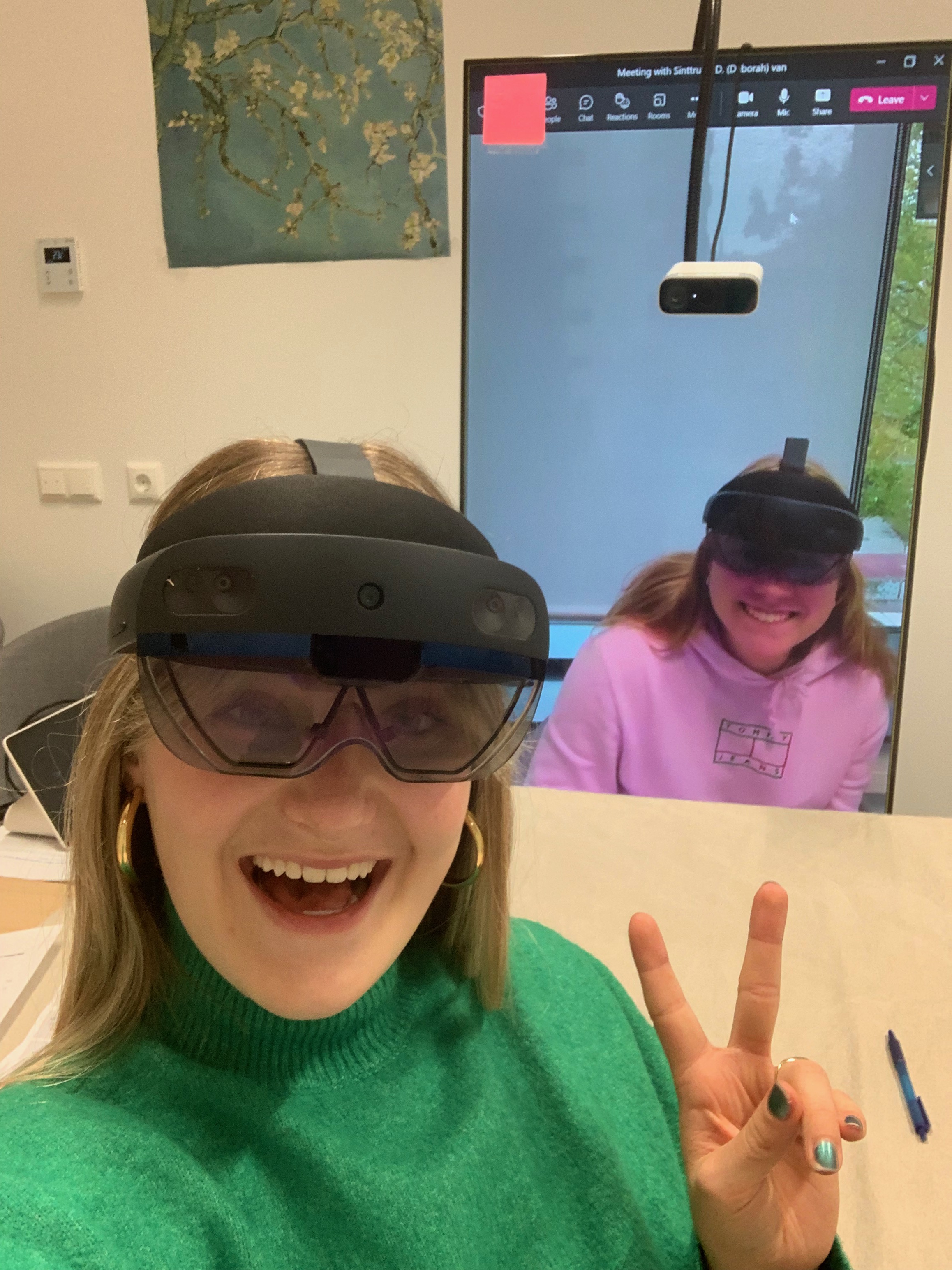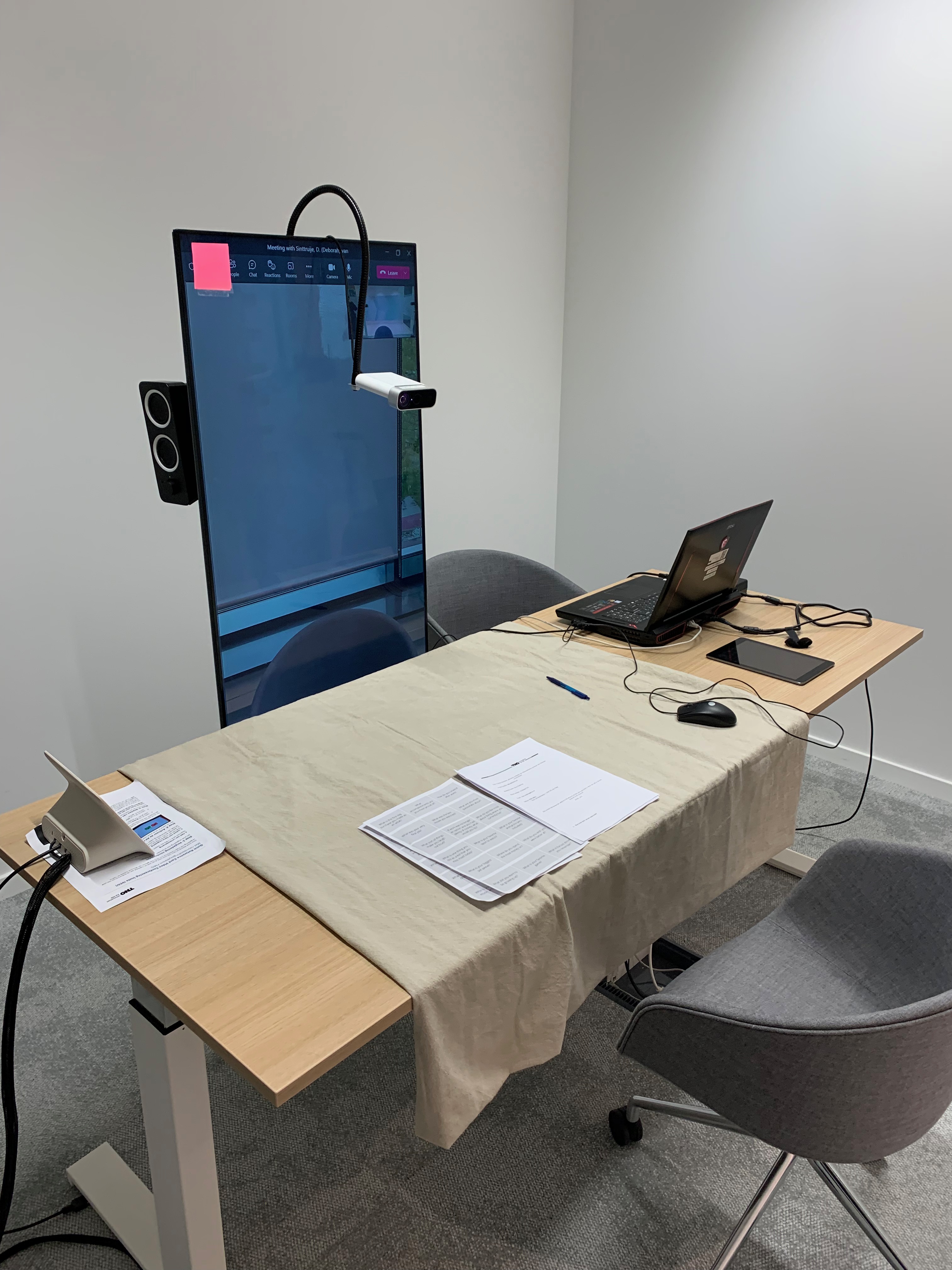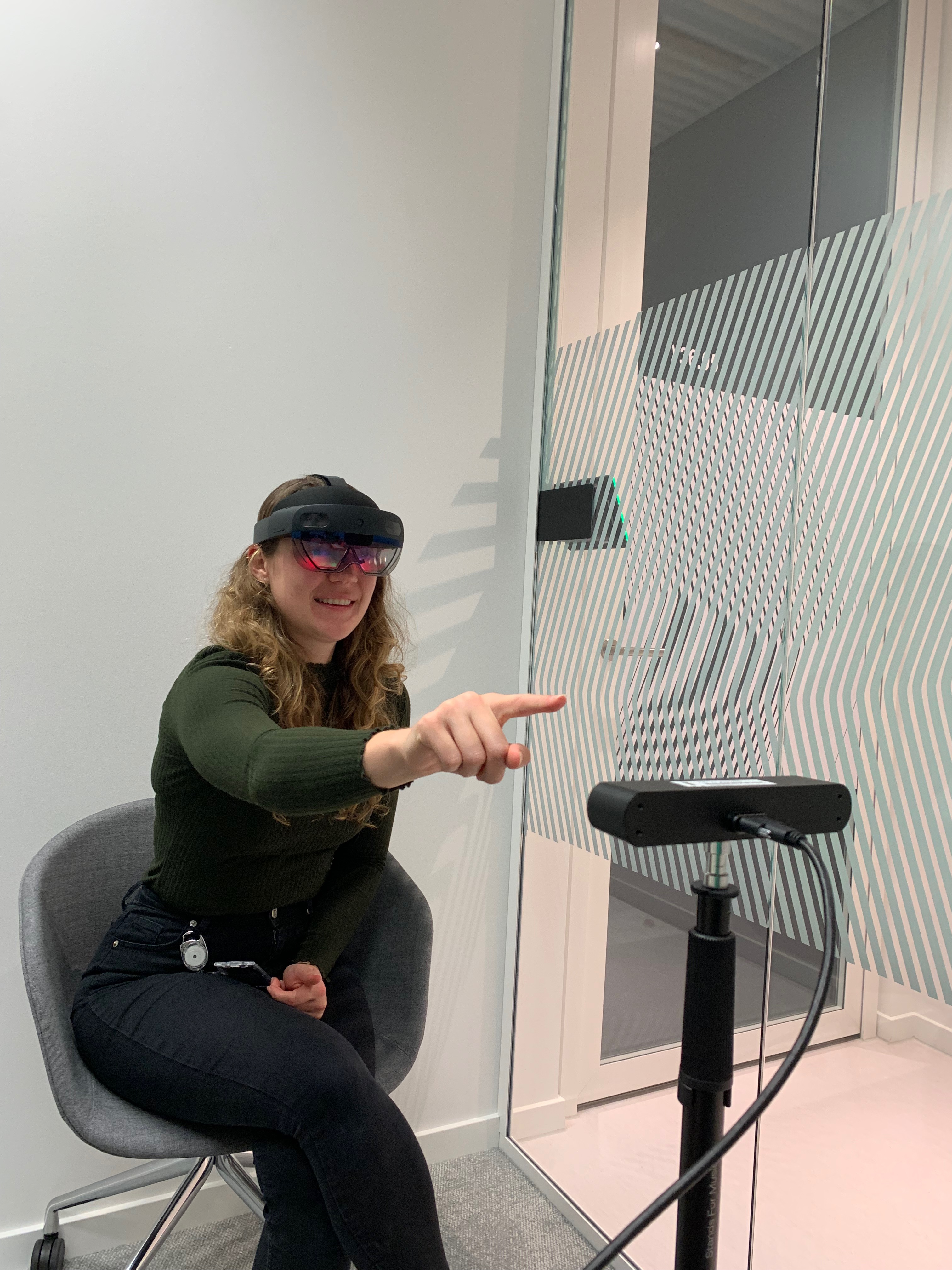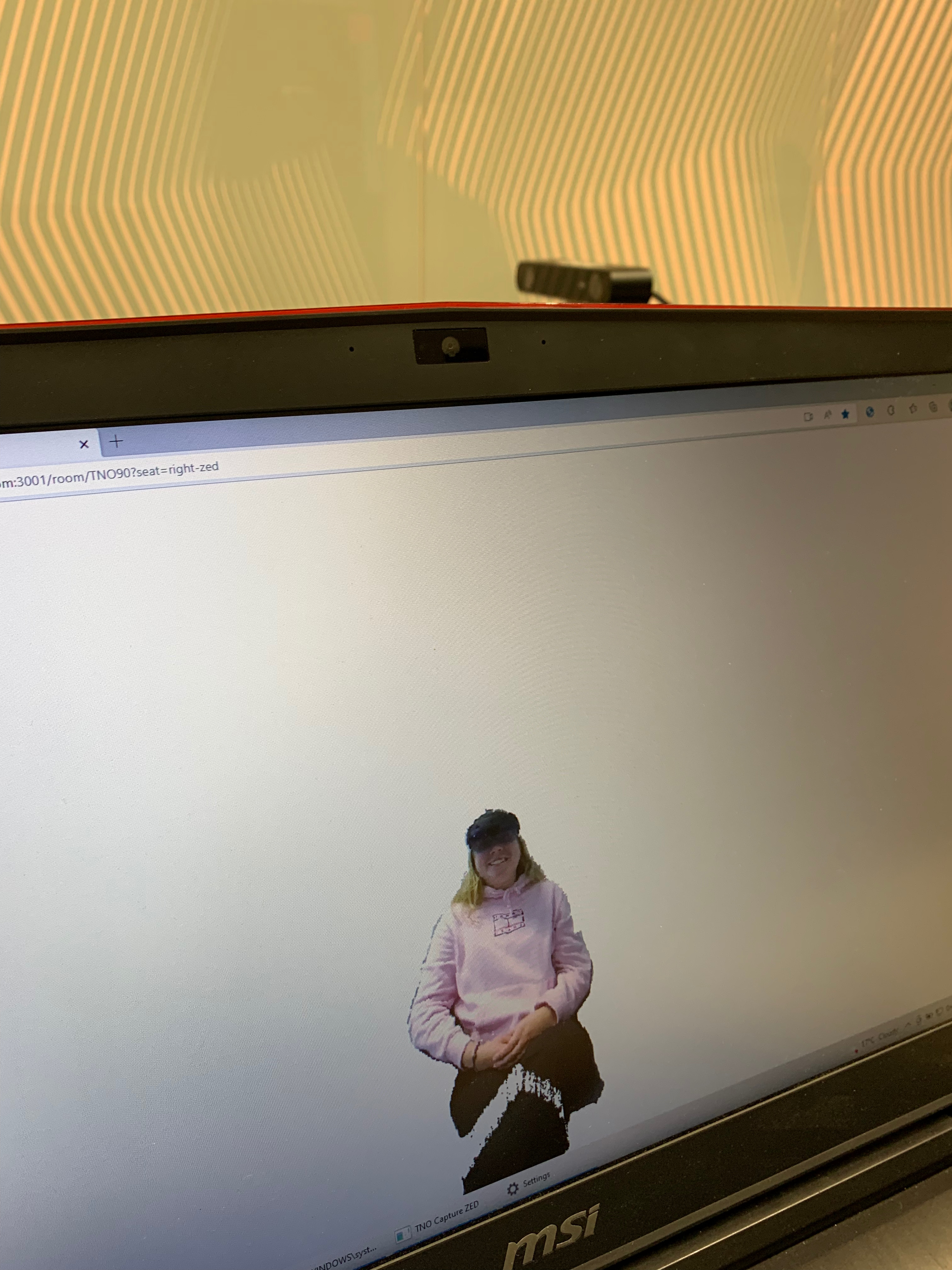
I Had a Hologram
Teams-call
Is the future of digital calls and meetings upon us? Recently, I participated in an experiment for my friend’s (Deborah Sintruije) research at the TNO (The Dutch Organization for Applied Scientific Research) facility testing new technological tools that completely changed my vision of the future of digital interactions. I’m talking about VR holograms. Yes, Sci-Fi predictions of holograms are taking closer steps to reality. Of course, life-size holograms are not a new thing. Take the legendary digital performance of our nation’s deceased hero André Hazes in 2017. However, perhaps in the maybe nearby future, this type of technology will be accessible from inside our homes! Wonder how this looks? Lucky for you, I’ve documented the experiment with some lovely photos of my friend and me wearing the VR glasses. I will also provide my take on this new development concerning our previous class discussions.
The Experiment

“This sure isn’t your look”
– My friend
When Roos (my friend and co-participant) and I entered this new TNO research building, permeated by the smell of new IKEA furniture, we immediately separated into two different rooms. In the other room, Roos approached a similar setting as mine (see image below). The interior of the room was quite minimalistic. It consisted of: a table displaying the equipment and questionnaires; two swivel chairs; a large plasma TV screen facing one of the chairs behind the table, and a camera pointing toward the exact spot where I would be seated. Let’s not forget to mention the inspiring Van Gogh poster taped onto the wall that gave the room a less laboratory look (see image below).


During our digital conversations, we wore these HoloLens 2 Microsoft VR headsets, though nothing was activated in these glasses yet. Instead, Roos and I were to discuss any topic we’d like or use one of the conversation-starting questions printed for us on a separate sheet. I saw her image life-size on the TV screen in front of me, and because we were wearing these ridiculous head sets, our interactions started a bit awkward and giggly. However, after a while, the topics came naturally. Deborah told us beforehand that whenever ready we could continue to the next step of the experiment, or she would interrupt us after some time. Ultimately, Deborah ended our meaningful talk and asked how long we’d estimate the time of our conversation. It truly felt like only 10 minutes, and sometimes I had even forgotten we were partaking in this experiment! While filling in the questions describing our experiences, I secretly checked and saw that twice the amount of my estimated minutes had passed. The questionnaire tested the level of social presence in our interaction, how aware we had been of our surroundings, and to what extent we experienced the physical presence of the other person.
Hologram Convo
Then it was time to bring out the big guns. I was now going to interact with Roos’ hologram via the HoloLens 2. For the Digi-nerds among us, Deborah covered for me the technological details of this VR experience. To create a hologram, you need a ZED camera that captures a 3D image. With that image, we create a point cloud that is projected through the HoloLens. She describes the HoloLens as a computer ‘happening in front of your eyes’. I saw Deborah tapping ‘the air’ while operating the system. “I’m starting an application that activates the point cloud via the HoloLens that results in you seeing an ‘over-layer’ (the hologram image of Roos) on top of reality”.


Then it was time to bring out the big guns. I was now going to interact with Roos’ hologram via the HoloLens 2. For the Digi-nerds among us, Deborah covered for me the technical details of this VR experience. “To create a hologram, you need a ZED camera that captures a 3D image. With that image, we generate a point cloud and project this through the HoloLens.” She describes the HoloLens as a computer happening in front of your eyes. In the you can see her ‘tapping the air’ while operating the system. “I’m starting an application that activates the point cloud via the HoloLens that results in you seeing an ‘over-layer’ (the hologram image of Roos) on top of reality”.
Our findings
After the entire experiment finished, we all came together to share our experiences. Unfortunately, the system for the hologram interaction faced many technical errors. It wasn’t officially part of the research because the technology was relatively new. Therefore it caused the projections to lag every time Deborah had just refreshed the program. Roos and I might not have been able to engage in a long conversation, but the 1-minute talks in between set-ups were mind-blowing to me. I could not only see a pixelated version of Roos within my environment, but I also witnessed her movements in 3D! Due to the systems malfunctions, I was not yet entirely convinced of a high social presence of Roos. However, I could envision a future where people would conduct meetings or class discussions through their own HoloLenses!
The Future of VR in Society
‘Virtual Visits’
As an intern, my friend Deborah contributes to a larger research project called ‘Virtual Visits’. Virtual Visits started exploring digital possibilities for lonely elders to interact with others virtually during the COVID outbreak. Initially, the research encapsulated a 3D projection of a person on a TV screen. Now they’ve gone as far as to test whether a HoloLens could be an improvement for interactions on Microsoft Teams. The TNO is expanding its study cases to meetings, caretakers, or mentoring. “Our main goal is to bring people together through technology,” Deborah interestingly says. Hmm… where does this remind me of?
Digital Media Goes VR?
Last Wednesday, we Web Weavers discussed Lucia’s solo podcast on the digital regression she felt we were experiencing after COVID. The technological tools the university invested in to facilitate virtual lectures suddenly now seem wasted as barely any lecturer makes use of them. “Though many students could benefit from hybrid teaching,” Lucia noticed. Our lecturer dr. Angus Mol, however, argued that in reality, the technology is not yet there. “Besides the fact that it takes a lot of time for the lecturer to set up the system, Microsoft Teams is not sufficient to replace the interactive discussions we have here every Wednesday,” he has said.
The reason for that is, given our shared experiences on Teams calls, the social presence during these online lectures is not quite high. We see the other person in a small box, and whenever we switch to a different page the amount of ‘boxes’ in the corner of our screens reduces to 3 people. But what if we could entirely represent the physical presence of everyone in the room right now? Imagine the crucial information lost during a Teams meeting such as body language, the raising of a hand, or (one of my favorite ways of communicating) hand movements. With a HoloLense, all of this suddenly becomes available again.
Right now, the price of the Microsoft HoloLens 2 (€3,849) might not fit everyone’s budget (not even counting the €650,71 ZED camera necessary for the creation of a 3D image). So it won’t be very likely that we’d have a hologram class discussion next week. Nevertheless, isn’t most technology initially for the rich and eventually becomes accessible to the general public? Can you envision this being our future too?

References
Wikipedia’s definition of a point cloud: “A point cloud is a set of data points in space. The points may represent a 3D shape or object.”
From the Week 6 lecture The Platform Society: “Facebook’s mission: “Founded in 2004, Facebook’s mission is to give people the power to build community and bring the world closer together. People use Facebook to stay connected with friends and family, to discover what’s going on in the world, and to share and express what matters to them.””


It’s such a fun experiment! Remembering that hologram has already been used in entertainment purposes like the duet of Whitney Houston and Christina Aguilera and MJ, I realise that we have not really come so far with hologram as we would have expected! I am genuinely looking forward to the improvement of hologram, particularly the possibility of a multi-perspective hologram object 😀